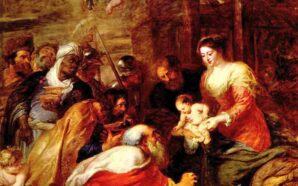Homily for the Second Sunday of Easter
Readings: Acts 4:32-35; 1 John 5:1-6; John 20:19-31
11 April 2021
Neither you nor I has ever seen the risen Jesus. Nor have we ever had the option like Thomas of putting our hands into his side or putting our finger into the holes which the nails had made. Neither you nor I will ever have the experience of those disciples in the closed room seeing the risen Jesus and then being filled with joy. Nor will we ever have the experience of Mary who stood outside the tomb able to cling to the risen Jesus. But in John’s gospel today, we are assured that sufficient signs have been recorded so that we too may believe that Jesus is the Christ, the son of God, and that believing this, we may have life through his name.
Listen at https://soundcloud.com/frank-brennan-6/homily-11421
Like the disciples, each of us has our fears. Like the disciples, we often close ourselves in our rooms at a safe distance from the world. Like the disciples, we are consoled when we hear that message of Jesus: “Peace be with you”.
Scripture scholar Francis Moloney, who incidentally will be joining us for the council dinner here in the college on Wednesday evening, writes: “Mary is led to believe in the risen Lord by means of an appearance, a desire to touch, and a commission. The disciples are blessed with the proclamation of Mary, the sight of the risen body, and Jesus’ commissioning of them for the mission. Thomas believes in Jesus as Lord and God by means of an appearance, a desire to touch, and a challenge.” Moloney highlights something which is good news for us who have come upon this scene 21 centuries later: “In this procession of faith experiences, the Beloved Disciple stands out.”
We recall that it was the Beloved Disciple who was with Mary at the foot of the cross and who heard Jesus say: “This is your mother”. It was the Beloved Disciple who ran to the tomb with Peter and who saw nothing more than the linen cloths lying on the ground. That was enough for him to see and believe. Moloney explains the range of beliefs in this way: “John tells his audience that the Beloved Disciple sees and believes, but he does not see the risen Jesus, nor does he seek physical confirmation of a risen body. Seamlessly, the original Gospel closes by explaining the blessedness of those who, like the Beloved Disciple, believe without seeing.”[1] Those blessed ones who do not see include you and me.
On Easter Tuesday, we received the news of the death of the Swiss theologian Hans Kung, aged 93 years. Kung was a very talented young theologian at the Second Vatican Council. I commenced my life as a Jesuit in 1975, just ten years after the end of that council. In the novitiate, we novices were introduced to the bold thinking of Hans Kung on topics like the Church and papal infallibility. Thereafter during our theology studies, Hans Kung every few years would publish a massive theological tome. First came his book On Being a Christian, and then Does God Exist? An Answer for Today.
Some of these writings were too much for the Vatican officials. In 1979, the Congregation for the Doctrine of the Faith (CDF) declared that Kung had “departed from the integral truth of Catholic faith, and therefore he can no longer be considered a Catholic theologian nor function as such in a teaching role”.[2] But we still read him and were inspired by his energy and openness.
Other theologians like the Americans Charles Curran and Roger Haight were to suffer similar fates. However they all kept theologising, and thank God they did. The American moral theologian Charles Curran on learning of Kung’s death said, “I am grateful for Hans Kung, for his stellar contributions to theology and to the life of the Catholic Church. But I am even more grateful for the pastoral ministry he showed me in a time of need.”[3]
When Kung heard that Curran was in trouble with Vatican officials he flew to see him, have lunch and offer support. Curran recalls, “Like many, I learned from his many and varied writings, but above all, I am grateful for a side of Hans Küng that many did not experience — his willingness to go out of his way to minister to and encourage me in my need.”
When Pope Benedict was a young theologian, Kung gave the up-and-coming Joseph Ratzinger an academic position. Over time, their theological differences became acute. But in September 2005, Pope Benedict invited Kung to a long lunch and they agreed to disagree. After the lunch, Kung said, “It’s clear that we have different positions. But the things we have in common are more fundamental. We are both Christians, both priests in service of the church, and we have great personal respect for one another.”
When he was retiring from public life in 2012, Kung reflected on the career paths of Benedict and himself and said, “There are two ways of being a Catholic. I think I represent the other way well, while he represents the first one. But if there were a public vote, as in my own country, I think it’s clear who would have a majority. He knows I am an honest person. And I think he knows very well that I am a good Catholic in my own way and that I am not alone at all [in my views]. He respects me and also my scholarship. ….It will be decided by history whose ideas ultimately win over, I think. Books survive many popes.”[4]
In this farewell interview with the American journalist Robert Mickens, Kung was asked, “What will you say when you finally meet God?” Küng paused for a moment. Then he looked up and said, “Have mercy on me”.
Another theologian disciplined by the CDF, Fr Roger Haight SJ observes: “Küng never internalized the medieval synthesis that characterized the Catholic theological imagination right up to Vatican II. He thought historically, and this meant being attentive to how concepts and language reflect the culture, time and sensibility of historical situations.”[5]
In his 1978 book Does God Exist? An Answer for Today, Kung explaining the aim of the book asked a series of questions reflecting the culture, time and sensibility of our historical situation: “We may, however really begin to wonder if Christianity has not come to an end? Is it not all over with belief in God? Has religion any future? Can we not have morality even without religion? Is not science sufficient? Has not religion developed out of magic? Will it not perish in the process of evolution? Is not God from the outset a projection of man (Feuerbach), opium of the people (Marx), illusion of those who have remained infantile (Freud)? Has atheism not been proved and is nihilism not irrefutable? Have not even theologians finally given up proving God’s existence? Or are we supposed to believe even without reasons? Simply believe? Can we not doubt everything except mathematics and what we can observe, weigh and measure? Would not the ideal be mathematical certainty? Or is there simply no ground for certainty?”[6] These are the very questions we all wrestle with as people of faith, as Easter people, as those who have not seen and yet believed.
When Kung came to consider the reality of resurrection, he said that resurrection “means a life that bursts through the dimensions of space and time in God’s invisible, imperishable, incomprehensible domain. …. Resurrection therefore means positively that Jesus did not die into nothingness, but in death and from death, died into that incomprehensible and comprehensive absolutely last/absolutely first reality, was indeed taken up by that most real reality, which we designate by the name of God.”[7]
For Kung, the choice was clear: “either I die into nothingness” or “I die into that absolutely last reality”. Kung greatly respected those who held the sincere conviction that they would die into nothingness, conceding that “those who have decided on the negative answer are not the smallest minds in history”. He said, “Like everything connected with atheism and nihilism, it cannot be refuted, but neither can it be positively proved. There has never been anyone who proved that we die into nothingness.” For Kung, this was not the reasonable option. He conceded that the possibility of dying into that absolutely last reality which we call God “cannot be positively and rationally proved, but neither can it be refuted”. Kung asserted that he could rely upon it “in an absolutely reasonable, enlightened trust. It seems more reasonable, it seems reasonable every time, that I should die not into nothingness but into God.”[8]
Reflecting on Jesus’ resurrection, Kung claimed that God was not only the God of the beginning, but also the God of the end, not only the Alpha, but also the Omega. God “is both my Creator and my Finisher. I can therefore rely with absolutely reasonable confidence on dying – like Jesus of Nazareth – in death, with death, out of death, into God; or – better – on being taken up by him.”[9]
Kung asserted: “I cannot verify empirically the passing from death into God anymore than the entry into nothingness can be empirically verified. Going to God is something that is not to be expected and not to be proved, but to be hoped for in faith.” Kung acknowledged that not even the resurrection of Jesus has been proved by historical arguments. For Kung, “There is no way to eternal life that bypasses faith.”[10]
After 700 pages, Kung addresses the question Does God Exist? with the simple affirmation that “despite all upheavals and doubts” the answer begins with faith, “You, God, we praise”, and ends in trust, “In you Lord, I have hoped, I shall never be put to shame.”[11] Having concluded our Lenten journey and lit the Paschal candle, let us emerge from behind whatever are the closed doors to our faith and understanding, and be shining lights as witnesses to the glories of the resurrection and the mercy of God. Always be willing to accompany the other, particularly those in greatest need, and to share the Easter gift of peace with others, especially those with whom we passionately disagree. Though we have not seen, we do believe. As Easter people, we go forth with a song in our hearts proclaiming, “My Lord and my God, have mercy on me.”
[1] F Moloney, ‘John’, The Paulist Biblical Commentary, Paulist Press, New York, 2018, p 1179
[2] See https://www.vatican.va/roman_curia/congregations/cfaith/documents/rc_con_cfaith_doc_19791215_christi-ecclesia_en.html
[3] Charles Curran remembers Hans Küng, National Catholic Reporter, 9 April 2021,
https://www.ncronline.org/news/people/charles-curran-remembers-hans-kung
[4] Robert Mickens, ‘Tablet Interview: I’m a good Catholic in my own way’, The Tablet, 27 October 2012, p. 11
[5] Roger Haight, ‘Hans Küng, influential Vatican II theologian censured by John Paul II, dies at 93’, America, 6 April 2021 at https://www.americamagazine.org/faith/2021/04/06/hans-kung-death-obituary-vatican-ii-240394
[6] Hans Kung, Does God Exist? An Answer for Today, Collins, London, 1980, p. xxi
[7] Ibid, p. 679
[8] Ibid.
[9]Ibid.
[10] Ibid, p. 680
[11] Ibid, p. 702
Fr Frank Brennan SJ is the Rector of Newman College, Melbourne, the Distinguished Fellow of the PM Glynn Institute, Australian Catholic University, and the former CEO of Catholic Social Services Australia (CSSA).








